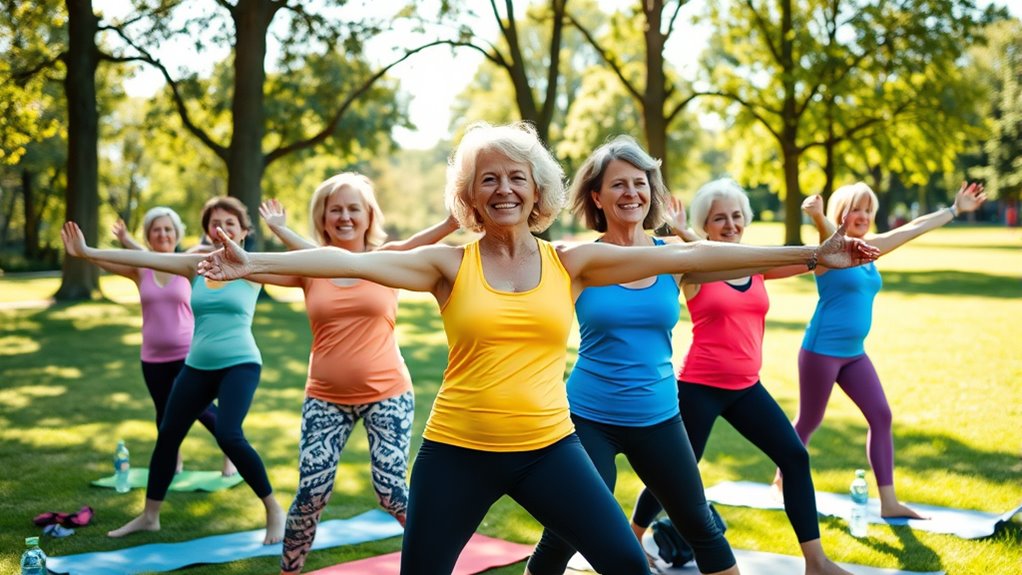Strength training workouts are essential for older women to feel strong and confident. By improving muscle mass, balance, and bone density, you can combat the effects of aging and enhance overall well-being. Focus on key exercises like the Leg Press and Chest Press, and customize your routine to match your needs. Safety is important, so avoid high-impact activities. Plus, incorporating cardio will boost your heart health. Discover more about how to create the perfect workout for yourself!
Key Takeaways
- Engage in strength training at least twice a week to build muscle, enhance bone density, and improve overall functional strength.
- Focus on key exercises like the Leg Press, Chest Press, and Lat Pulldown to strengthen major muscle groups safely.
- Customize workouts to individual goals, considering any physical limitations or injuries for a safe and effective routine.
- Incorporate low-impact cardio activities like walking or swimming for heart health while minimizing joint stress.
- Prioritize proper form and gradual progression in weight to avoid injuries and boost confidence in your abilities.
The Importance of Strength Training for Older Women
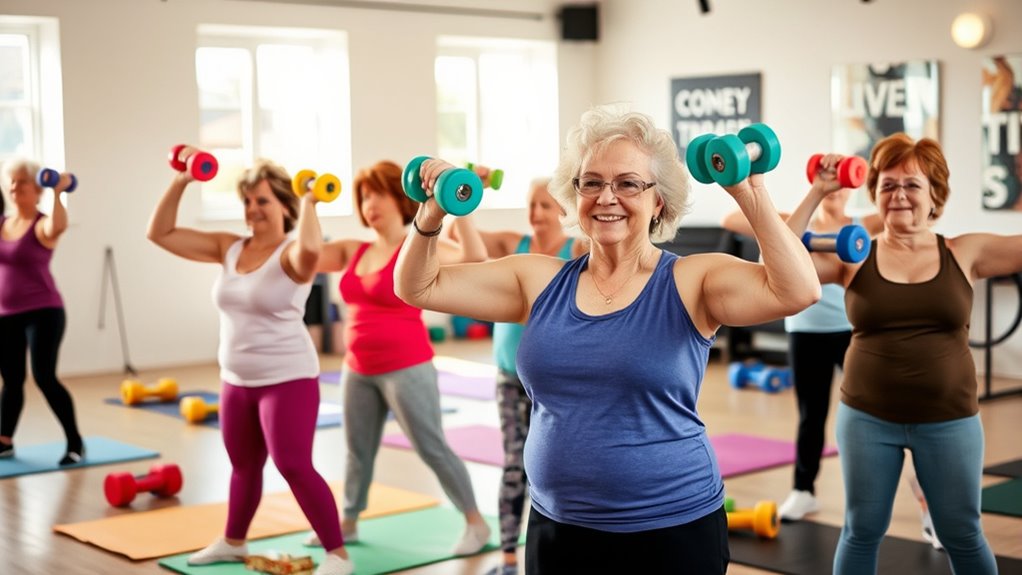
As you age, incorporating strength training into your routine becomes increasingly essential to maintain your muscle mass and overall health.
Strength training is important for older women, as it combats sarcopenia, the age-related muscle loss that accelerates after 60. By engaging in regular sessions, you’ll not only preserve muscle but also enhance your bone density, greatly reducing the risk of osteoporosis and fractures. This is particularly important during and after menopause when bone mass declines rapidly. Additionally, strength training improves your functional strength, mobility, and balance, helping to prevent falls and injuries. According to the American College of Sports Medicine, it is recommended to engage in at least two sessions per week, making it critical for promoting a healthy metabolism and overall well-being. Furthermore, incorporating nutritional support can further enhance your strength training results and overall health. Regular exercise routines can also improve your cardiovascular health, which is vital as you age. Moreover, studies show that effective training can significantly boost your confidence and mental well-being as you navigate the aging process. Engaging in personalized learning pathways through guided exercise programs can also help you discover the most effective strength training techniques tailored to your needs.
Key Benefits of Regular Workouts
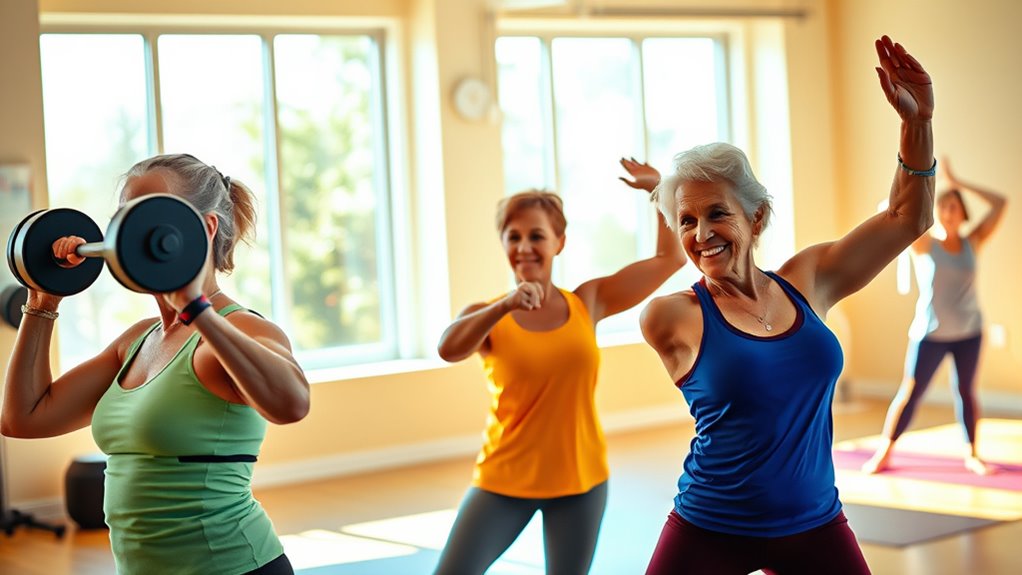
Regular workouts can greatly boost your physical strength and enhance your overall well-being. You’ll not only feel more confident in your abilities but also enjoy improved mental health, making daily challenges easier to tackle. Embracing a consistent exercise routine can truly transform how you feel about yourself and your life. Additionally, engaging in self-care practices can further support your journey toward strength and confidence. By prioritizing data-driven decision-making, you can choose workout routines that best fit your personal health goals and needs. Incorporating whole foods into your diet can also complement your workout efforts by providing essential nutrients for recovery and energy. Moreover, establishing clear career goals can empower you to maintain focus on your fitness journey. The practice of gentle stretching can also enhance flexibility and reduce the risk of injury during workouts.
Enhanced Physical Strength
While you might think that aging naturally leads to a decline in physical strength, consistent workouts can actually reverse this trend. Engaging in strength training for women helps you maintain muscle mass, which is essential as you age. Studies show that without regular exercise, you could lose 3–8% of muscle mass per decade after age 30, with losses accelerating post-60. Strength training not only increases lean muscle but also improves bone density, greatly reducing the risk of osteoporosis. Additionally, regular physical activity enhances balance and coordination, decreasing your likelihood of falls. By committing to a structured workout routine, you empower yourself, boosting your strength and overall confidence in daily activities. Furthermore, incorporating mindfulness practices into your routine can enhance your self-awareness and improve your overall mental resilience. Practicing self-reflection can help you identify your progress and areas for improvement along your fitness journey. Engaging in effective relaxation techniques can also complement your workouts by reducing stress and enhancing recovery. Developing cultural intelligence through diverse interactions can also contribute positively to your mental well-being and self-confidence.
Improved Mental Health
Engaging in workouts can greatly boost your mental health, offering numerous benefits that go beyond physical fitness. Regular strength training reduces anxiety and depression, enhancing your overall well-being. You’ll notice an increase in self-esteem and a positive body image, helping you feel more confident in your skin. Additionally, resistance training is linked to improved cognitive function, potentially slowing cognitive decline as you age. This is supported by the importance of nutrition in brain development, which highlights the role of healthy eating habits in maintaining mental health. Consistent exercise elevates dopamine and serotonin levels, essential for mood regulation. Incorporating omega-3 rich foods into your diet, such as chia seeds, can further support mental health and overall wellness. Furthermore, seasonal arrangements in your environment can create a calming atmosphere that complements your mental well-being. Seeking professional help may further enhance your mental well-being as you navigate the emotional challenges of life. Having a structured plan for your fitness routine can also contribute to financial security in the long-term, ensuring you stay active and healthy into retirement.
Increased Confidence Levels
As you embrace a consistent workout routine, you might find your confidence levels rising greatly.
Regular strength training exercises not only build muscle but also enhance your self-esteem and body image. You’ll likely feel a sense of accomplishment as you notice improvements in your physical abilities, leading to greater self-efficacy in daily tasks. Engaging in physical activity can also support emotional well-being as it promotes the release of endorphins, which can elevate your mood. Additionally, participating in music therapy can further enhance emotional regulation, complementing your workout routine. This holistic approach fosters emotional intelligence, enabling you to better manage stress and interpersonal relationships.
This boost in confidence can greatly reduce feelings of anxiety and depression, helping you cultivate a more positive self-image. Women over 50 who engage in regular workouts report higher satisfaction with their bodies and overall well-being.
As you continue on this fitness journey, you’ll discover that your newfound strength directly reinforces your confidence, motivating you to stay active and empowered. Incorporating a budget plan for fitness-related expenses can also contribute to a more structured and fulfilling workout experience.
Recommended Strength Training Exercises
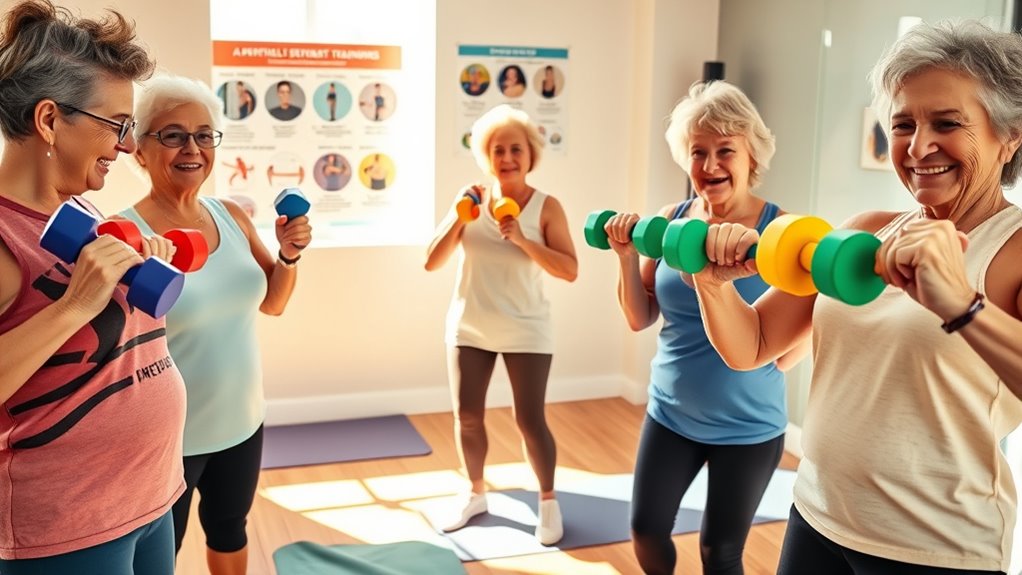
When it comes to strength training, focusing on key exercises is essential for building muscle and enhancing overall fitness.
You’ll want to contemplate safety measures and customize your routine to fit your individual needs and abilities.
Let’s explore some recommended exercises that can help you stay strong and active.
Key Strength Exercises
Strength training is essential for older women, providing numerous benefits that enhance overall well-being.
Key exercises like the Leg Press target your lower body, improving bone density and mobility. The Chest Press strengthens your upper body, making daily lifting easier. Incorporating Lat Pulldown exercises enhances upper body strength and improves your back aesthetics.
Don’t forget the Leg Curls, which maintain hamstring strength important for movement. The Abdominal Machine is critical for core strength, helping with balance and stability as you age.
Remember, modified versions of these exercises can accommodate any joint issues, ensuring safety while building strength effectively.
Regularly engaging in these recommended exercises combats age-related muscle loss and boosts your functional strength and confidence.
Safety Considerations
While incorporating strength training into your routine can greatly benefit your health, it’s essential to prioritize safety to avoid injuries.
Here are some important safety considerations to keep in mind:
- Use Proper Form: Make sure you maintain proper form during each exercise to minimize the risk of injury.
- Start Slowly: Begin with lighter weights and gradually increase as your strength improves.
- Avoid High-Impact Movements: Steer clear of exercises that put excessive strain on your joints, especially if you have pre-existing issues.
- Listen to Your Body: Pay attention to any discomfort or pain; stop if something doesn’t feel right.
Customization for Individuals
To effectively enhance your strength training routine, customizing exercises to fit your individual needs is crucial. This guarantees you address any limitations, injuries, or fitness goals, maximizing safety and effectiveness. Here are some recommended exercises tailored for your capabilities:
| Exercise | Target Area | Notes |
|---|---|---|
| Leg Press | Lower Body | Adjust weight as needed |
| Chest Press | Upper Body | Focus on form over weight |
| Lat Pulldown | Back Strength | Use a lighter grip if necessary |
| Stability Ball Chest Fly | Core & Stability | Gentle on joints |
| Dead Bug | Core Strength | Great for overall stability |
Emphasizing customization in your strength training routine will empower you to build muscle safely and effectively. Aim for 8 to 12 repetitions to promote growth.
Customizing Workouts for Individual Needs
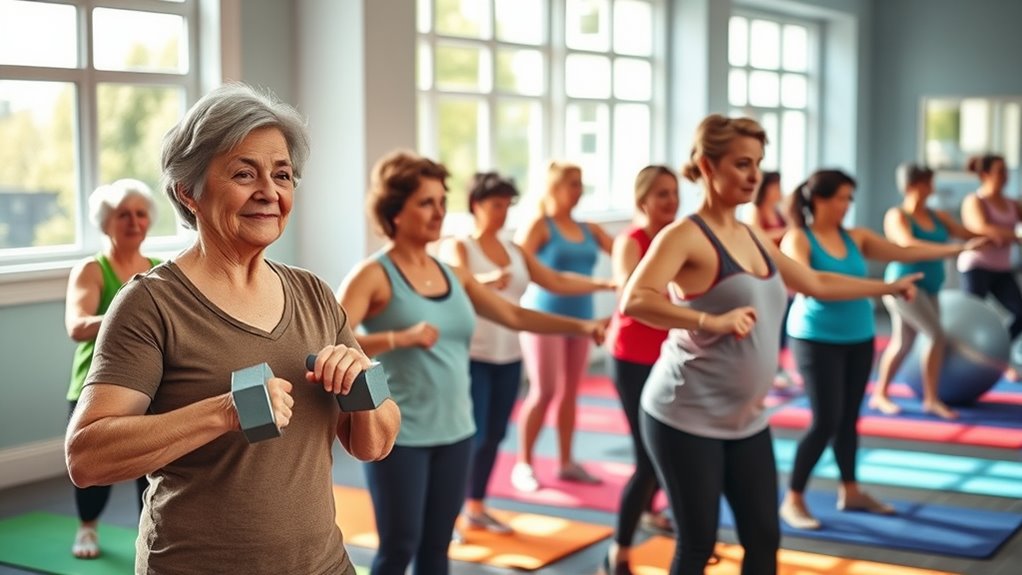
Customizing workouts for older women requires a thoughtful assessment of individual limitations, fitness goals, and any pre-existing injuries. By tailoring your routine, you can create a safe and effective exercise plan that meets your unique needs.
Tailoring workouts for older women involves assessing goals, limitations, and injuries to ensure a safe and effective fitness plan.
Here are some key considerations:
- Identify Goals: Determine what you want to achieve, whether it’s strength, balance, or flexibility.
- Evaluate Limitations: Consider any physical restrictions or injuries that may require modified exercises.
- Adjust Intensity: Personalize exercise intensity to guarantee comfort while still challenging yourself.
- Incorporate Feedback: Listen to your body during workouts and adjust exercises as needed for ideal comfort and effectiveness.
Safety Considerations and Exercises to Avoid

When it comes to staying active as you age, safety should always be a top priority. High-impact movements like running or jumping can lead to joint injuries and falls, so it’s best to avoid them. If you have joint issues, consider low-impact alternatives like swimming or cycling to keep your cardiovascular fitness without straining your joints. Be cautious with exercises involving overhead pressing, especially if you have shoulder injuries. Always listen to your body—painful exercises should be avoided, even if modified. Before starting any new exercise program, consult a healthcare professional to verify it’s safe for your individual health conditions.
| Avoid These Exercises | Consider Instead | Notes |
|---|---|---|
| Running | Swimming | Joint-friendly |
| Jumping | Cycling | Low-impact option |
| Overhead presses | Resistance bands | Gentle strength training |
Incorporating Cardio for Overall Health
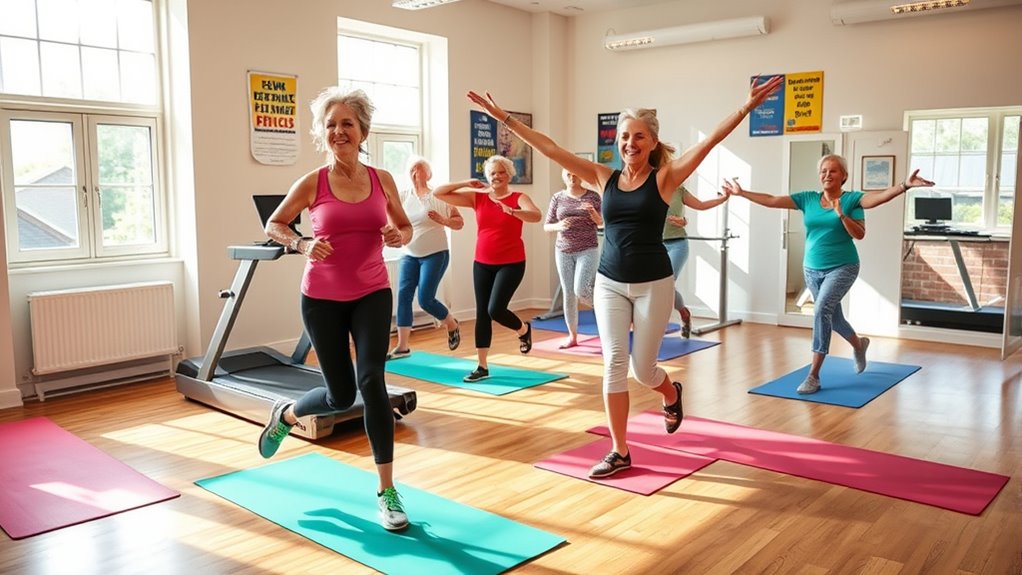
Staying active doesn’t just mean avoiding risky exercises; it also involves incorporating effective cardiovascular activities into your routine.
Cardio is essential for maintaining overall health, especially as you age. It can enhance your mood, improve sleep quality, and support weight management.
Here are some great low-impact options to take into account:
- Walking: A simple way to get your heart rate up and enjoy nature.
- Swimming: Gentle on the joints while providing a full-body workout.
- Cycling: A fun way to boost cardiovascular fitness without the impact.
- Slow-motion strength training: Combines muscle building with cardio benefits.
Aim for at least 150 minutes of moderate-intensity cardio each week to reap these rewards!
Real-Life Success Stories: Women Who Thrive Through Fitness
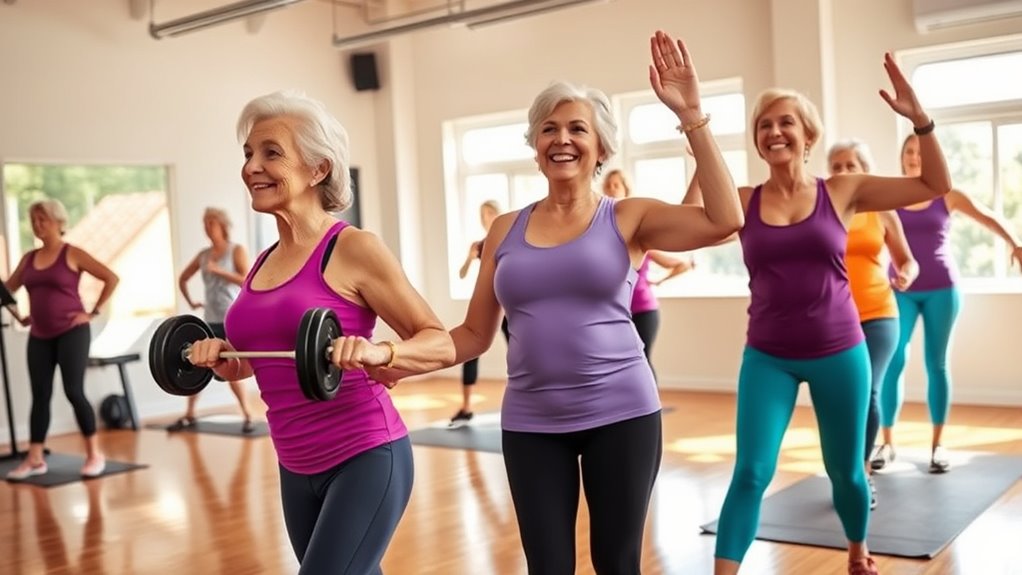
Many women in their 60s and beyond are transforming their lives through fitness, proving that it’s never too late to embrace a healthier lifestyle.
Take Client A, who improved her upper back strength through a customized strength training plan, boosting her posture and confidence.
Client B, at 68 and living with osteoporosis, increased her bone density and felt more energetic, allowing her to engage in social activities without fear of injury.
Meanwhile, Client C lost 15 pounds and enhanced her overall health by following tailored routines focused on pain management.
Studies show that older adults participating in regular strength training experience a 30% increase in self-esteem, and 85% of community program participants report feeling empowered and confident.
Frequently Asked Questions
What Is the Best Strength Training for Older Women?
When considering the best strength training for older women, focus on exercises that build muscle and maintain bone density.
You’ll want to include key movements like leg presses, chest presses, and lat pulldowns. Aim for at least two sessions per week.
Incorporating slow-motion techniques can enhance cardiovascular benefits while keeping injury risks low.
What Is the 6 12 25 Rule?
The 6-12-25 rule is a strength training guideline that helps you effectively build muscle and improve endurance.
You perform 6 reps of high-weight exercises, 12 reps of moderate-weight exercises, and 25 reps of low-weight exercises.
This combination not only stimulates different muscle fibers but also enhances your overall fitness.
How Can a 60 Year Old Woman Strengthen Their Core?
Imagine yourself standing tall, the sun warming your back, feeling the power of a strong core beneath you.
To strengthen your core, try modified planks and bird dogs—these exercises engage your abdominal muscles gently. Incorporate stability ball exercises like the hamstring bridge to boost flexibility and coordination.
Aim for 2 to 3 sessions a week, doing 8 to 12 repetitions each time. You’ll not only improve your stability but also enhance your overall strength.
What Is the Number One Exercise as You Get Older?
As you get older, the number one exercise to focus on is strength training.
It’s essential for maintaining muscle mass and functional strength. By incorporating exercises like squats and deadlifts into your routine, you can enhance your mobility and endurance.
Aim for at least two sessions a week to combat age-related muscle loss and improve your overall physical ability.
You’ll not only feel stronger but also boost your confidence and mental well-being.
Conclusion
As you embrace strength training, think of yourself as a sturdy oak tree, roots deep and branches reaching high. Each workout empowers you, nurturing confidence and resilience. Just like the tree stands tall against the winds, you’ll find yourself capable of facing life’s challenges head-on. Remember, it’s not just about lifting weights; it’s about lifting your spirit and embracing your strength. Now go out there and flourish, knowing you’re strong, capable, and ready to thrive!

